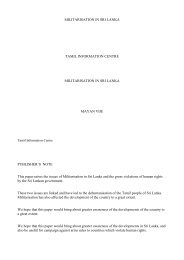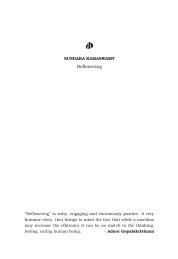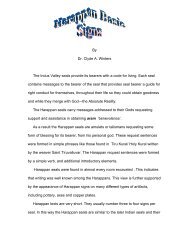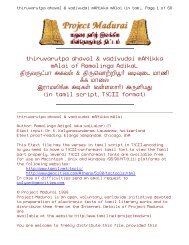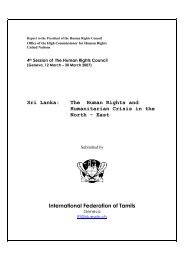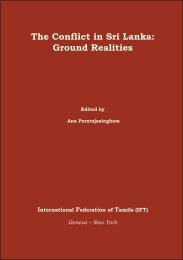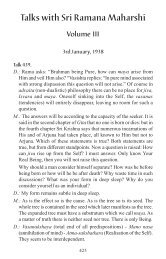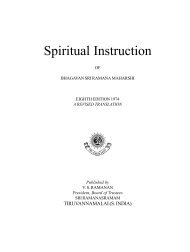Tamil Script Book: Learner's Manual - Sankaran Radakrishnan
Tamil Script Book: Learner's Manual - Sankaran Radakrishnan
Tamil Script Book: Learner's Manual - Sankaran Radakrishnan
Create successful ePaper yourself
Turn your PDF publications into a flip-book with our unique Google optimized e-Paper software.
<strong>Tamil</strong> <strong>Script</strong>/<strong>Sankaran</strong> Radhakrishnan<br />
4. Hard palate: It is a concave part of the roof of the mouth. It is in the central<br />
part of the roof of the mouth.<br />
5. Soft palate: This is situated in the back part of the roof of the mouth. It can be<br />
lowered or raised. When it is lowered, the air stream from the lungs has access to<br />
the nasal cavity. When it is raised the passage to the nasal cavity is closed.<br />
6. Uvula: It is the ending part of the soft palate.<br />
7. Pharynx: It is situated in the throat. The surface of the tongue is divided into<br />
three parts namely the blade of the tongue, the front of the tongue, and the back of<br />
the tongue.<br />
8. Blade of the tongue: it lies opposite to the teeth ridge. It includes the tip of the<br />
tongue.<br />
9. Front of the tongue: It lies opposite to the hard palate.<br />
10. Back of the tongue: It lies opposite to the palate.<br />
11. Epiglottis: This is drawn over the windpipe when swallowing.<br />
12. Vocal cords: The larynx contains two lip-like elastic membranes that are<br />
physiologically called vocal cords. When these two are brought close together<br />
during the sound production, they vibrate and produce a buzzing noise. This is<br />
called voice and the particular sound produced at this time is termed voiced sound<br />
or soft sound. A sound produced without such vibrations in the vocal cords is a<br />
voiceless sound or simply hard sound.<br />
13. Larynx: It is the upper part of the windpipe. It protects the vocal cords.<br />
The speech sounds are produced mainly based on articulators and points of<br />
articulation. The articulators are movable and points of articulation are stationary.<br />
The articulators are lower lip, tip of the tongue, and blade of the tongue, front of<br />
the tongue and back of the tongue. The points of articulation are upper lip, teeth,<br />
teeth ridge, hard palate and soft palate.<br />
<strong>Tamil</strong> speech sounds are generally divided into vowels and consonants. Vowels<br />
are voiced sounds. In their production the air passes through the mouth in a<br />
continuous stream without any obstruction in the mouth. In the production<br />
process of the vowels, the soft palate is in its raised position and vocal cords are<br />
in vibration. The consonants are produced with obstructions and are many.<br />
These details are found in the place where they are introduced in the following<br />
Frames.<br />
It is to be observed here the difference between the letters and their sound values.<br />
In <strong>Tamil</strong> some letters are used for different sound values. That is, one particular<br />
letter will be used for different sounds. The different sound values of some<br />
consonants and their distributions are given as and when they are introduced. The



